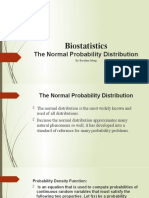Theoretical Distributions 2
Theoretical Distributions 2
Uploaded by
bnanduriCopyright:
Available Formats
Theoretical Distributions 2
Theoretical Distributions 2
Uploaded by
bnanduriCopyright
Available Formats
Share this document
Did you find this document useful?
Is this content inappropriate?
Copyright:
Available Formats
Theoretical Distributions 2
Theoretical Distributions 2
Uploaded by
bnanduriCopyright:
Available Formats
statistics
CA FOUNDATION - PAPER 3: BUSINESS MATHEMATICS,
LOGICAL REASONING AND STATISTICS
This capsule is in continuation to the previous edition featured in November 2021. Further here presented properties
of Normal Distribution and their applications. Here an attempt is made to the enable the students to understand the
concepts Binomial, Poisson and Normal distribution with the help of examples.
Chapter 17 : Theoretical Distributions
Some important points relating to normal distribution are listed (d) The normal distribution is known as biparametric
below: distribution as it is characterised by two parameters µ
(a) The name Normal Distribution has its origin some two hundred and σ2. Once the two parameters are known, the normal
years back as the then mathematician were in search for a distribution is completely specified.
normal model that can describe the probability distribution of
most of the continuous random variables.
(b) If we plot the probability function y = f (x), then the curve, Properties of Normal Distribution
known as probability curve, takes the following shape: 1. Since π = 22/7 , e–θ = 1 / eθ > 0, whatever θ may be,
it follows that f (x) 0 for every x.
It can be shown that
2. The mean of the normal distribution is given by µ. Further, since
the distribution is symmetrical about x = µ, it follows that the
mean, median and mode of a normal distribution coincide, all
being equal to µ.
3. The standard deviation of the normal distribution is given by
Mean deviation of normal distribution is
The first and third quartiles are Q1 = μ– 0.675 σ and Q3 = μ+
0.675 σ
-∞ x=µ ∞ so that, quartile deviation = 0.675 σ
4. The normal distribution is symmetrical about x =μ. As such,
Mean = Median = Mode its skewness is zero i.e. the normal curve is neither inclined
move towards the right (negatively skewed) nor towards the
Showing Normal Probability Curve. A quick look at figure reveals left (positively skewed).
that the normal curve is bell shaped and has one peak, which 5. The normal curve y = f (x) has two points of inflexion to be
implies that the normal distribution has one unique mode. The given by x = μ – σ and
line drawn through x = µ has divided the normal curve into two x = μ + σ i.e. at these two points, the normal curve changes its
parts which are equal in all respect. Such a curve is known as curvature from concave to convex and from convex to concave.
symmetrical curve and the corresponding distribution is known 6. If x ~ N (μ, σ2 ) then z = x – µ/σ ~ N (0, 1), z is known as
as symmetrical distribution. Thus, we find that the normal standardised normal variate or normal deviate.
distribution is symmetrical about x = µ. It may also be noted that We also have P (z ≤ k ) = φ (k) The values of φ(k) for different k
the binomial distribution is also symmetrical about p = 0.5. We next are given in a table known as “Biometrika.”
note that the two tails of the normal curve extend indefinitely on 7. Area under the normal curve is shown in the following figure:
both sides of the curve and both the left and right tails never touch
the horizontal axis. The total area of the normal curve or for that
any probability curve is taken to be unity i.e. one. Since the vertical
line drawn through x = µ divides the curve into two equal halves, it
automatically follows that,
The area between – ∞ to µ= the area between μ to ∞ = 0.5
When the mean is zero, we have
the area between – ∞ to 0 = the area between 0 to ∞ = 0.5
(c) If we take μ = 0 and σ = 1 , we have
f(x) = for –∞< z <∞
The random variable z is known as standard normal variate
(or variable) or standard normal deviate. The probability that a (z=3) (z=-2) (z=-1) (z=0) (z=1) (z=2) (z=3)
standard normal variate X would take a value less than or equal
to a particular value say X = x is given by
φ(x) = p ( X ≤ x )
(x) is known as the cumulative distribution function.
We also have (0) = P ( X ≤ 0 ) = Area of the standard normal
curve between –∞ and 0 = 0.5
The Chartered Accountant Student February 2022 29
statistics
Area Under Normal Curve => 4p = 6 - np
From the figure , we have => 4p = 6 - 10/3
P (µ – σ < x < µ + σ ) = 0.6828 => 4p = 8/3
=> P (–1 < z < 1 ) = 0.6828 => p = 2/3
P ( µ – 2 σ < x < µ + 2σ ) = 0.9546 np = 10/3 => n = 5
=> P (– 2 < z < 2 ) = 0.9546 probability that X assumes at most the value 2 = P(0) + P(1) + P(2)
and P ( µ – 3 σ < x < µ + 3σ ) = 0.9973 = ⁵C₀(2/3)⁰(1/3)⁵ + ⁵C₁(2/3)¹(1/3)⁴ + ⁵C₂(2/3)²(1/3)³
=> P (– 3 < z < 3 ) = 0.9973. = 1/243 + 10/243 + 40/243 = 51/243= 17/81
We note that 99.73 per cent of the values of a normal variable lies
between (µ – 3 σ) and (µ + 3 σ). Thus the probability that a value of
3. Assuming that one-third of the population is tea drinkers and
x lies outside that limit is as low as 0.0027.
each of 1000 enumerators takes a sample of 8 individuals to find
8. If x and y are independent normal variables with means and
out whether they are tea drinkers or not, how many enumerators
standard deviations as µ1 and µ2 and σ1, and σ2 respectively,
are expected to report that five or more people are tea drinkers?
then z = x + y also follows normal distribution with mean (µ1 +
Solution: Assume that being a tea drinker is like taking a flip of
µ2) and SD = respectively.
coin.(i.e. either the person drinks tea or not) with the probability of
i.e. If x ~ N (µ1, σ12) and y ~ N (µ2, σ22) and x and y are heads being 1/3 and tails being 2/3
independent, now P(X≥5) =P(X=5)+P(X=6)+P(X=7)+P(X=8) = (56*8+28*4+8*2+1)
then z = x + y ~ N ( µ1 + µ2, σ12 + σ22) /6561 = 577/6561 =0.087943 so for 1000 trials the number of trials
which report greater than or equal to 5 is 1000*P(X>=5) = 87.94 =88
Applications of Normal Distribution
4. If a random variable x follows binomial distribution with mean as
Most of the continuous variables like height, weight, wage, profit
5 and satisfying the condition 10. P (x= 0) = P(x= 1) , what is the value
etc. follow normal distribution. If the variable under study does
of P( X≥1/X>1) ?
not follow normal distribution, a simple transformation of the
Solution:
variable, in many a case, would lead to the normal distribution of
the changed variable.
When n, the number of trials of a binomial distribution, is large
and p, the probability of a success, is moderate i.e. neither too
large nor too small then the binomial distribution, also, tends to
normal distribution. Poisson distribution, also for large value of
m approaches normal distribution. Such transformations become
necessary as it is easier to compute probabilities under the
assumption of a normal distribution.
Some Important Problems
1. What is the probability that out of 10 missiles fired, atleast 2 will
hit the target
Solution: Probability of atleast 2 will hit the target is given as,
P(X ≥ 2) = 1 − P(X < 2)
The probability of a missile hitting a target is 1 /8
P(X ≥ 2) = 1 − [P(X = 0) + P(X = 1)] 5. Out of 128 families with four children each, how many are
= 1 − [¹⁰C₀ × (1/8)^0 × (7/8)^10 + ¹⁰C₁ × (1/8)^1 × (7/8)^9] expected to have atleast have one boy and one girl?
= 1 − [7^10/8^10 + (10 × 7^9)/8^10] Solution: 4 children in a family can be in
= 1 − [7^10 + 10 × 7^9] / 8^10 2 * 2 * 2 * 2 = 16 ways
= 1 − (17 × 7^9) / 8^10 at least one boy and one girl = Total cases - all boys - all girs
P(X ≥ 2) ≈ 0.3611 = 36.11% All boys = 1 case, All girls = 1 case
Therefore, the probability that out of 10 missiles fired, atleast 2 will => at least one boy and one girl = 16 - 1 - 1 = 14
hit the target is 0.3611. Probability of at least one boy and one girl = 14/16
out of 128 families expected to have = 128 * 14/16 = 8 * 14 = 112
2. Given X is a binomial variable such that 2 P(X = 2) = P(X = 3) and 112 Families expected to have at least one boy and one girl
mean of X is known to be 10/3. What would be the probability that
X assumes at most the value 2 6. In 10 independent rollings of a biased die, the probability that
Solution: an even number will appear 5 times is twice the probability that
mean = 10/3 , Mean = np = 10/3 an even number will appear 4 times. What is the probability that
P(X) = ⁿCxpx(1-p)ⁿ-x an even number will appear twice when the die is rolled 8 times?
=> P(2) = ⁿC₂p²(1-p)ⁿ-2 Solution: Probability of even number p = p
P(3) = ⁿC₃p³(1-p)ⁿ-3 Then probability of odd number (or not even number) = q = 1 - p
P(3) = 2 P(2) Probability Appearing 5 times
=> ⁿC₃p³(1-p)ⁿ-3 = 2 ⁿC₂p²(1-p)ⁿ-2 ¹⁰C₅ * p⁵ * q¹⁰-⁵
=> p/3!(n-3)! = (2 /2!(n-2)! )(1 - p) = ¹⁰C₅ * p⁵ * q⁵
=> p/6 = (1-p)/(n - 2)
=> np - 2p = 6 - 6p
30 February 2022 The Chartered Accountant Student
statistics
Probability Appearing 5 times 11. What is the probability of getting 3 head if 6 unbiased coins are
¹⁰C₄ * p⁴ * q¹⁰-⁴ tossed simultaneously?
= ¹⁰C₄ * p⁴ * q⁶ Solution: if x denotes the number of heads, then x follows binomial
¹⁰C₅ * p⁵ * q⁵ = 2 * ¹⁰C₄ * p⁴ * q⁶ distribution with parameters n = 6 and p = probability of success
=>p * 10!/5!5! = 2q * 10!/6!4! =½
=> p * 6 = 2q * 5 q= probability of failure = 1-1/2 = ½ , being given the coins are
=> 3p = 5q => 3p = 5(1 - p) unbiased
=> 8p = 5 The probability mass function of x is given by
=> p = 5/8 & q = 1 - 5/8 = 3/8
probability that an even number will appear twice when the die is f(x) = 6C3 . = 20 = 0.3125
rolled 8 times
= ⁸C₂ * p²q⁸-²
= 28 * (5/8)² (3/8)⁶ 12. In Binomial Distribution n = 9 and p = 1/3 , What is the value
= 28 * 25 * 3⁶ / 8⁸ of variance .
= 700 * 3⁶ / 8⁸ Solution: In Binomial Distribution variance = npq , here n= 9 , p
= 5,10,300/1,67,77,216 = 0.0304 = 1/3 and q= 2/3
Therefore variance = 9*1/3*2/3 = 2
7. What is the probability of making 3 correct guesses in 5 true-
13. For a Binomial Distribution E(x) = 2 , V(X)= 4/3 . Find the value
False answer type questions?
of n
Solution: Here P = 0.5 and q = 0.5 ( Since answer can be either True
Solution: Here E(X) = np = 2
or False ) n= 5, r = 3
V(x)= npq = 4/3 then substituting the value of np
P(x=r) = nCr px.qn-x
2×q = 4/3
P(x=3) = 5C3 (0.5) 5.(0.5)5-3 =0.3125
2q = 4/3
q= 2/3 then p = 1-2/3 = 1/3
8. Suppose that weather records show that on an average 5 out of 31 np = 2, n×1/3 = 2 , n= 6
days in October are rainy days. Assuming a binomial distribution
which each day of October as an independent trail, then the
probability that the next October will have at most three rainy days 14. The mode of Binomial Distribution for which the mean is 4 and
is: variance 3 is equal to?
Solution: p = Probability of a rainy day in October :p = 5/31, q = Solution: In Binomial Distribution Mean = np = 4 and Variance
probability of a non-rainy day in October q = 1- p = 1-5/31 = 26/31 = npq = 3
n = 31 (number of days in October) Then 4q = 3 q = ¾ , p = 1-q = 1-3/4 = ¼
n×1/4 = 4 therefore n = 16
P(x) = 31Cr. (n+1) p = (16+1) ×1/4 = 4.25 which is no longer integer.
So mode = 4
Required Probability = P (0) + P (1) +P(2) +P(3)
= 31C0. + 31C1. + 15. In a Binomial Distribution with 5 independent trials, probability
of 2 and 3 successes are 0.4362 and 0.2181 respectively. Parameter
‘p ‘of the Binomial Distribution is
31C2. + 31C3. Solution: Given n = 5 , P(x=2) = 0.4362
P(x=3) =0.2181
= 0.2403 P(x=3) = 5C3 . =10
0.2181 = 10.P3.q2
And P(X=2) =5C2 . =10
0.4362 = 10
By dividing
9. If 5 days are selected at random, then the probability of getting 0.2181/0.4362 =
two Sundays is:
Solution: Let P = Probability of getting a Sunday in a week (P) = 1/7 ½= q/p
Therefore P = 1/7 and q= 1-p = 1-1/7 = 6/7 q= 2p; 2p+p = 1
3p = 1, then p = 1/3
Required probability = 15C2 . = 0.288 = 0.29
16. What is the first quartile of X having the following probability
density function?
10. An experiment of succeeds twice as often as it falls. What is the
f(x) = for – ∝ < × < ∝
probability that in next five trials there will at least three successes?
Solution: According to the given statement p = 2q Solution: First Quartile Deviation (Q1) = μ- 0.675σ here
We know that p = 2/3 q= 1/3 By comparing probability density function of Normal Distribution,
Required probability P( X≥3) = P(3) +P(4) +P(5) Mean = 10 and σ = 4
Q1 = 10-0.675(6) =10-4.05 = 5.95
= 5C3 . + 5C4 . + 5C5 .
The Chartered Accountant Student February 2022 31
You might also like
- R - A Practical CourseDocument42 pagesR - A Practical CourseS M Ataul KarimNo ratings yet
- Stochastic Modelling Notes DiscreteDocument130 pagesStochastic Modelling Notes DiscreteBrofessor Paul NguyenNo ratings yet
- Normal Probaility DistributionDocument13 pagesNormal Probaility DistributionAbdul TukurNo ratings yet
- Continuous Probability DistributionDocument60 pagesContinuous Probability DistributionJethro MiñanoNo ratings yet
- Types of Random VariablesDocument4 pagesTypes of Random VariablesHazell DNo ratings yet
- Lecture No.10Document8 pagesLecture No.10Awais RaoNo ratings yet
- Multi Varia Da 1Document59 pagesMulti Varia Da 1pereiraomarNo ratings yet
- NormalDocument23 pagesNormalDenys Rivera GuevaraNo ratings yet
- PSS Week 6Document10 pagesPSS Week 6ansh bhargavaNo ratings yet
- BasicsDocument61 pagesBasicsmaxNo ratings yet
- Normal Distribution & It's PropertiesDocument11 pagesNormal Distribution & It's Propertiesakartik7904No ratings yet
- Normal DistributionDocument26 pagesNormal DistributionUmesh ChandraNo ratings yet
- LectureDocument6 pagesLectureJubillee MagsinoNo ratings yet
- Quiz 2 Covered Materials In: - Chapter 5 - Chapter 6 - Chapter 7Document27 pagesQuiz 2 Covered Materials In: - Chapter 5 - Chapter 6 - Chapter 7Aaron Hayyat0% (1)
- Chapter 6Document33 pagesChapter 6Kartika PutriNo ratings yet
- Normal DistributionDocument29 pagesNormal DistributionGuard'z SmieyeleNo ratings yet
- Probability PresentationDocument26 pagesProbability PresentationNada KamalNo ratings yet
- Prof Stanley Dukin Lectures Statistical MechanicsDocument43 pagesProf Stanley Dukin Lectures Statistical MechanicsEdney GranhenNo ratings yet
- Week 7 ProbDocument32 pagesWeek 7 ProbIslam TokoevNo ratings yet
- Normal DistributionDocument30 pagesNormal Distributionbraulio.dantas-1No ratings yet
- Measure VariabilityDocument6 pagesMeasure VariabilityAlexander DacumosNo ratings yet
- Biostatistics For Academic3Document28 pagesBiostatistics For Academic3Semo gh28No ratings yet
- New Aongs 2023Document11 pagesNew Aongs 2023fadikhan7007No ratings yet
- Kuliah 14Document23 pagesKuliah 14Nurul Khoir ElbhekasiNo ratings yet
- Class 1 Chapter 14 Nuclear Counting Statistics: INME - Principles of Radiation Physics Chapter 14 - Page 1Document18 pagesClass 1 Chapter 14 Nuclear Counting Statistics: INME - Principles of Radiation Physics Chapter 14 - Page 1أحمدآلزهوNo ratings yet
- Topic20 8p7 GalvinDocument53 pagesTopic20 8p7 GalvinJude SantosNo ratings yet
- Normal DistributionDocument59 pagesNormal DistributionAkash Katariya100% (1)
- PROSTAT Lecture9 HandoutsDocument6 pagesPROSTAT Lecture9 HandoutsJubillee MagsinoNo ratings yet
- ECONOMICSRGUDocument105 pagesECONOMICSRGUDaniel DuraiNo ratings yet
- Sri Zakiyah - 2208152 - Distribusi Data NormalDocument4 pagesSri Zakiyah - 2208152 - Distribusi Data NormalSri ZakiyahNo ratings yet
- PHY224H1F/324H1S Notes On Error Analysis: ReferencesDocument14 pagesPHY224H1F/324H1S Notes On Error Analysis: ReferencesHoàng Thanh TùngNo ratings yet
- Handout For Chapters 1-3 of Bouchaud: 1 DenitionsDocument10 pagesHandout For Chapters 1-3 of Bouchaud: 1 DenitionsStefano DucaNo ratings yet
- MAT217PART5Document28 pagesMAT217PART5amodafoluwakeNo ratings yet
- Most Important Theoratical Questions of QTDocument26 pagesMost Important Theoratical Questions of QTIsmith PokhrelNo ratings yet
- Testing of Hypothesis Unit-IDocument16 pagesTesting of Hypothesis Unit-IanohanabrotherhoodcaveNo ratings yet
- Multivariate AnalysisDocument25 pagesMultivariate AnalysisPaul EthamNo ratings yet
- Robust StatisticsDocument11 pagesRobust Statisticssantoso22No ratings yet
- Hypothesis Testing 23.09.2023Document157 pagesHypothesis Testing 23.09.2023Sakshi ChauhanNo ratings yet
- Probability & Probability Distribution 2Document28 pagesProbability & Probability Distribution 2Amanuel MaruNo ratings yet
- 3.11 Hypothesis Testing-Tests Concerning Means and ProportionsDocument16 pages3.11 Hypothesis Testing-Tests Concerning Means and ProportionsTanmay SharmaNo ratings yet
- Multivariate Normal DistributionDocument9 pagesMultivariate Normal DistributionccffffNo ratings yet
- Grade11 Statistics and Probabilty - Module 3Document5 pagesGrade11 Statistics and Probabilty - Module 3Erickson SongcalNo ratings yet
- Chapter 3 StatisticDocument8 pagesChapter 3 Statisticsisayshimelis70No ratings yet
- Statistic and ProbabilityDocument15 pagesStatistic and ProbabilityFerly TaburadaNo ratings yet
- Descriptive Statistics For Hicm UndergraduateDocument18 pagesDescriptive Statistics For Hicm UndergraduateThelma FortuNo ratings yet
- Mathematical Foundations of Computer ScienceDocument24 pagesMathematical Foundations of Computer Sciencemurugesh72No ratings yet
- Lecture No.9Document12 pagesLecture No.9Awais RaoNo ratings yet
- Skewness and Kurtosis ExDocument6 pagesSkewness and Kurtosis ExChang GordonNo ratings yet
- Chapter 04Document56 pagesChapter 04Osama SamhaNo ratings yet
- Normal Probability DistributionsDocument8 pagesNormal Probability DistributionsCharmaine Reyes FabellaNo ratings yet
- ISE1204 Lecture4-1Document23 pagesISE1204 Lecture4-1tanaka gwitiraNo ratings yet
- 2 BMGT 220 Prob Distr FunctionsDocument4 pages2 BMGT 220 Prob Distr FunctionsPamela ChimwaniNo ratings yet
- Haan C T Statistical Methods in Hydrology SolutionDocument17 pagesHaan C T Statistical Methods in Hydrology Solutiongizem duralNo ratings yet
- 04 NormalDistributionDocument43 pages04 NormalDistributionShane Olen GonzalesNo ratings yet
- ch7 pt1 PDFDocument26 pagesch7 pt1 PDFShruti D MishraNo ratings yet
- Business Inferential Statistics LessonsDocument7 pagesBusiness Inferential Statistics Lessonsblessingszingwangwa49No ratings yet
- Diet of Random VariablesDocument8 pagesDiet of Random VariablesvirbyteNo ratings yet
- STRZDocument3 pagesSTRZibrahimiliyas.kiNo ratings yet
- Topic05.Normal DistrDocument27 pagesTopic05.Normal DistrDavid LeNo ratings yet
- Normal Distribution: X N X FDocument5 pagesNormal Distribution: X N X FK.Prasanth KumarNo ratings yet
- Mathematics 1St First Order Linear Differential Equations 2Nd Second Order Linear Differential Equations Laplace Fourier Bessel MathematicsFrom EverandMathematics 1St First Order Linear Differential Equations 2Nd Second Order Linear Differential Equations Laplace Fourier Bessel MathematicsNo ratings yet
- A-level Maths Revision: Cheeky Revision ShortcutsFrom EverandA-level Maths Revision: Cheeky Revision ShortcutsRating: 3.5 out of 5 stars3.5/5 (8)
- 5942021012511504293Document11 pages5942021012511504293bnanduriNo ratings yet
- 5942020092115454028Document22 pages5942020092115454028bnanduriNo ratings yet
- 5942020120813361085Document14 pages5942020120813361085bnanduriNo ratings yet
- Practice Worksheet: Johnson Grammar School L.B.Nagar, HyderabadDocument3 pagesPractice Worksheet: Johnson Grammar School L.B.Nagar, HyderabadbnanduriNo ratings yet
- Chapter 1-Numbers and Numeration: Johnson Grammar School, L.B.Nagar, HyderabadDocument2 pagesChapter 1-Numbers and Numeration: Johnson Grammar School, L.B.Nagar, HyderabadbnanduriNo ratings yet
- TDS & TCS - DT Nov 22Document4 pagesTDS & TCS - DT Nov 22bnanduriNo ratings yet
- Guru99 MacroDocument52 pagesGuru99 MacrobnanduriNo ratings yet
- NISM-Series-XII: Securities Markets Foundation Certification ExaminationDocument214 pagesNISM-Series-XII: Securities Markets Foundation Certification ExaminationbnanduriNo ratings yet
- Trade SettlementDocument3 pagesTrade SettlementbnanduriNo ratings yet
- @cahelp23 - Inter Costing Must Do List Nov2021Document120 pages@cahelp23 - Inter Costing Must Do List Nov2021bnanduriNo ratings yet
- Accounting Standards Supplementary Material - ImageDocument64 pagesAccounting Standards Supplementary Material - ImagebnanduriNo ratings yet
- Multi-Team Environment - Implementation Overview PDFDocument20 pagesMulti-Team Environment - Implementation Overview PDFbnanduriNo ratings yet
- Unit H PDFDocument9 pagesUnit H PDFbnanduriNo ratings yet
- Guide To Raising A Support Request PDFDocument7 pagesGuide To Raising A Support Request PDFbnanduriNo ratings yet
- Social Studies: Class IXDocument3 pagesSocial Studies: Class IXbnanduriNo ratings yet
- Guide To Blue Prism Tiles - 0 PDFDocument21 pagesGuide To Blue Prism Tiles - 0 PDFbnanduriNo ratings yet
- Guide To Send Keys and Send Key Events PDFDocument14 pagesGuide To Send Keys and Send Key Events PDFbnanduriNo ratings yet
- Logging Best Practices Guide PDFDocument12 pagesLogging Best Practices Guide PDFbnanduriNo ratings yet
- Extending MS Excel VBO PDFDocument3 pagesExtending MS Excel VBO PDFbnanduriNo ratings yet
- Guide To Reading Text With OCR PDFDocument3 pagesGuide To Reading Text With OCR PDFbnanduriNo ratings yet
- Foundation Training - ReadyTech User Guide PDFDocument4 pagesFoundation Training - ReadyTech User Guide PDFbnanduriNo ratings yet
- Questions Probability and Probability DistributionsDocument11 pagesQuestions Probability and Probability DistributionsDawood BotNo ratings yet
- Statistics 1 Normal Distribution: EdexcelDocument24 pagesStatistics 1 Normal Distribution: EdexcelAmber RafiqNo ratings yet
- Cambridge International ExaminationsDocument12 pagesCambridge International ExaminationsDiana Sari SMP TARA DenpasarNo ratings yet
- 1.bayes TheoremDocument9 pages1.bayes TheoremAkash RupanwarNo ratings yet
- Power Laws in The Information Production Process Lotkaian Informetrics (Leo Egghe) (Z-Library)Document447 pagesPower Laws in The Information Production Process Lotkaian Informetrics (Leo Egghe) (Z-Library)khimjon sarmaNo ratings yet
- Statistics and Probability - AssignmentDocument31 pagesStatistics and Probability - AssignmentSiva Kumar ArumughamNo ratings yet
- MetNum1 2023 1 Week 11 CorrectedDocument58 pagesMetNum1 2023 1 Week 11 Correcteddonbradman334No ratings yet
- Quiz6 Ch05 PDFDocument5 pagesQuiz6 Ch05 PDFEarthy Dream The100% (1)
- PRC SyllabusDocument17 pagesPRC SyllabusBakhtawarNo ratings yet
- AssignmentDocument3 pagesAssignmentNicholas Foster0% (1)
- M6 2020 Binomial Distribution Lecture NotesDocument27 pagesM6 2020 Binomial Distribution Lecture Notescoyite8695No ratings yet
- 1 Grade8 CollectOrganizeandDisplayData AODADocument9 pages1 Grade8 CollectOrganizeandDisplayData AODASalma JanNo ratings yet
- Stat 2220Document8 pagesStat 2220Nwogo DanielNo ratings yet
- Data Analysis-Univariate & BivariateDocument9 pagesData Analysis-Univariate & BivariateMeenakshi ChoudharyNo ratings yet
- UNIT 3 Principles of SamplingDocument4 pagesUNIT 3 Principles of SamplingHans PNo ratings yet
- Research VariablesDocument3 pagesResearch Variablesjustice kimaniNo ratings yet
- University of Central Punjab Faculty of EngineeringDocument3 pagesUniversity of Central Punjab Faculty of EngineeringYasirNo ratings yet
- Binomial Distribution Powerpoint 1Document17 pagesBinomial Distribution Powerpoint 1kailash100% (2)
- Quizit Best Quizizz and Kahoot Cheats Hacks and AnswersDocument25 pagesQuizit Best Quizizz and Kahoot Cheats Hacks and AnswersThao PhamNo ratings yet
- Calculator Skills - CasioDocument29 pagesCalculator Skills - Casio이상원No ratings yet
- PertDocument52 pagesPertMuhammad FawadNo ratings yet
- 03 Failure Distribution r1Document8 pages03 Failure Distribution r1Jie Lucas TzaiNo ratings yet
- Hypergeometric DistributionDocument9 pagesHypergeometric Distributiondanny222No ratings yet
- Ch06 Discrete Probability DistributionsDocument17 pagesCh06 Discrete Probability DistributionsMariA YAGHINo ratings yet
- Stats&Prob - WEEK 1Document3 pagesStats&Prob - WEEK 1Ji PaoNo ratings yet
- Vtu Me Transport First YearDocument46 pagesVtu Me Transport First YearAbhishek AbNo ratings yet
- Meanings of StatisticsDocument28 pagesMeanings of StatisticspapaoniNo ratings yet
- Library ScienceDocument63 pagesLibrary ScienceShaheryar SadiqNo ratings yet














































































































